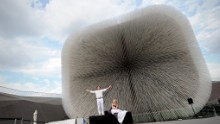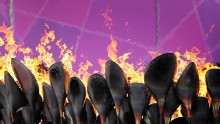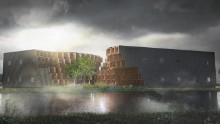

These are just a few of the questions 45-year-old British designer Thomas Heatherwick and his team have asked -- and answered -- with works such as the shimmering Bleigiessen, the playful Rolling Bridge, and the form-defying UK Pavilion at the Shanghai World Expo in 2010.
The latter -- a hairy structure made up of 60,000 acrylic rods, each tipped with a unique seed from the UK's Royal Botanic Gardens -- put Heatherwick on the map.

Actors perform in front of the UK Pavilion at the site of the 2010 World Expo in Shanghai.
"Dandelion," as it was later nicknamed by the Chinese public, beat out more than 200 national pavilions to win the event's top design prize, with a striking concept that didn't fall back on cultural stereotypes.
"The U.K. Pavilion in particular changed the future of Heatherwick Studio," says Kate Goodwin, Head of Architecture at the Royal Academy of Arts in London.
"It demonstrated that the studio could work on a large scale and create something completely extraordinary that would stay in the collective imagination."
Inside Heatherwick Studio
A small model of the UK Pavilion features prominently at the China Academy of Fine Arts (CAFA) museum in Beijing, as part of Inside Heatherwick Studio, a new exhibition touring Asia.
Also on display are seats from the redesigned London Routemaster bus and copper petals from the Olympic Cauldron, two high-profile projects produced by the studio following the huge success of the World Expo.
Goodwin, who curated the exhibition, has put forth a collection of 125 objects sourced from two decades worth of studio archives. These include photos, renderings, sketchbooks, test pieces and models, many of which have never been made public.

The Thomas Heatherwick designed Cauldron burns bright during the 2012 Paralympic Games in London.
The exhibition's three main sections -- thinking, making, storytelling -- are a nod to the creative, experimental process applied to each of Heatherwick's projects, be it furniture, infrastructure, or buildings.
Looking at his body of work, Heatherwick's style is difficult to pinpoint. There's no single, identifiable feature, or obvious company trademark.
As Heatherwick explains: "So often when people build big buildings and places, they paralyze. There's so much money involved. So they do what they think is safe, which is to do something very similar to what other people do."
This idea of safety, suggests the designer, is contributing to the creation of a uniform landscape: "It's the most disappointing thing -- to travel to the other side of the world, and think it looks very similar to the place you came from. In fact, that seems to be the challenge of our time: cities are becoming increasingly similar to each other, because global procurement is so similar."
Upcoming projects
Currently, the studio has just over 20 ongoing projects, including the divisive Garden Bridge in London, and the widely publicized collaboration between Heatherwick and Danish architect Bjarke Ingels on Google's new headquarters.
While the Google design does not appear in the Asia-facing exhibit, the show does provide visitors with a first look at the studio's ambitious new "mega-structure" near Shanghai.
Early models and renderings show a mixed-use development reimagined as an undulating landform, with trees and plants weaving throughout concrete pillars. Were it to be completed in 2018 as estimated, the sprawling 2.91 million square foot (270,000 square meters) development would be the largest project by the studio to date.
During a public talk in Beijing, Heatherwick debuted renderings of a current project just outside Futian, China.
Commissioned by Chinese fashion brand Tangy, the concept behind the design is an industrial shed, pulled apart to create two separate areas -- a public exhibition space, and a studio.
The modest structure aims to compliment the area's surrounding fishponds and will be completed by the end of this year.
Heatherwick says there's a necessity to design for human scale in countries like China, where colossal developments can feel both impersonal and impenetrable.
"We can use nature as a softening, humanizing device to bring human scale in."

"I think that's the challenge in Chinese city making," he continues.
"And how to have ideas that aren't just individual buildings, but how to have an idea for a whole city. That's much harder. It's easier to do one freak building -- like, 'Oh look, the foreign architect came and did that!' But, how do you make a place feel relevant and particular?"






 Add Category
Add Category